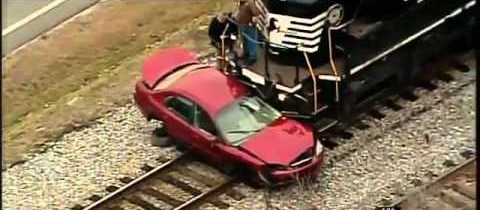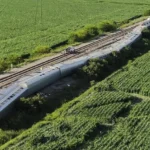Grade Crossing Crashes: What to Do?
I’ve written here before about one of the more serious problems facing the country’s railroads: grade crossing accidents. There are a lot of them … far too many because, with the exception of those that are suicides, every damn one of them could have been avoided.
It’s a big problem and, unfortunately, it’s probably going to get bigger. There are several reasons why these awful incidents occur but, discounting the suicides for the purpose of this exercise, in almost all of the other incidents, drivers ignore the flashing lights and the clanging bells and they drive around the lowered gates into the path of the locomotive … even those hauling relatively slow-moving freights.

Obviously, they think they have enough time and some of the time, they do. A lot of those incidents occur in small towns all across the midwest and the west. Twenty or thirty times a day, the bells start to ring, the lights start flashing and the gate comes down . . . and after a full minute or so, here comes a freight train, rumbling through town at 30 miles an hour.
But once a day, it’s not a slow freight. Once a day, it’s Amtrak—barreling through that same intersection at 70 miles an hour and some impatient driver, assuming it’s a freight and that he’s got plenty of time, pulls out of line, drives around the barrier, and … BOOM!
So how could this bad situation get worse? There are a number of routes around the country where improvements are being made in the track that will permit Amtrak trains to run at 110 miles an hour. Chicago-St, Louis and stretches in Michigan, for example, and there are several other routes where higher speeds are being considered.
The problem is obvious, isn’t it? The higher the train’s speed, the shorter the time from the gate dropping until it reaches the crossing and the shorter the time the impatient driver has to drive around the gate and get safely across. If it’s a Union Pacific freight he makes it; if it’s the Southwest Chief, he doesn’t. And the faster the Chief is traveling, the lower the odds he’ll make it.
The maddening thing is, idiots drive around the gates and get hit by freight trains, too.
Fixing the problem—really fixing the problem—would take massive amounts of money and thousands of lesser-used crossings would still have to be closed. That’s not going to happen.




It’s similar in other countries, unfortunately. Although there are ways they try to minimize the problem. For instance, in the Netherlands, many railway crossings have been closed, but others have been adapted so train numbers are recognized by the system, and when a train is supposed to stop in the station right before the crossing, the gates will close later, allowing for more traffic to pass. A direct train or freight train will make the gates close immediately, of course.
The Swiss have mandated that their freight trains have to run not only at a maximum speed, but also a minimum speed, allowing for their time slot to be similar to the rest of the traffic. They, too, have hardly any crossings left. But admittedly, in Europe, it’s passenger trains that are the base of railway traffic, unlike the US where sometimes only 2 passenger trains pass a day, but heavy freight traffic exists. So it’s not easy to compare, but that doesn’t mean one can’t learn something from other people’s solutions…
At some grade crossings–I think it was in Germany–I remember seeing metal plates popping up to block anyone from trying to cross once the warning has sounded. But I guess the only foolproof way for preventing a fool from killing himself is an overpass or underpass.
It might be Germany, yes, I have heard about them, too. And, if you get stuck between the barriers, you could still drive over them, I believe.
Over and underpasses are the best, but also the costliest, both in money and in land taken in. In the field, that may not seem worth it, and in the city, those buildings right next to the crossings might be quite difficult to obtain. Plus, as a person without a car, a bridge is nothing for a car, but on foot or on bicycle, that might be a little harder… Still, not as hard as going the long way ’round, because they ‘merged’ two crossings some hundreds of meters apart into one bridge. Some hundreds of meters is done in seconds by a motorist, a cyclist needs perhaps 5 minutes more, but a pedestrian can easily loose up to 15 minutes, if he’s unlucky…
So I must admit, I kinda understand people that cross the roads without a proper passage, obviously putting them into more danger than when they would have been able to cross at an official crossing… With a crossing, the barrier that is a railroad is lessened to some extent, but without it, you could just as well have built a wall between 2 parts of a city. That’s why a city needs ways to cross easily, be it by crossings, tunnels, bridges, or, when money is no problem, a railway tunnel, which also eliminates the noise problem. But yeah, money.